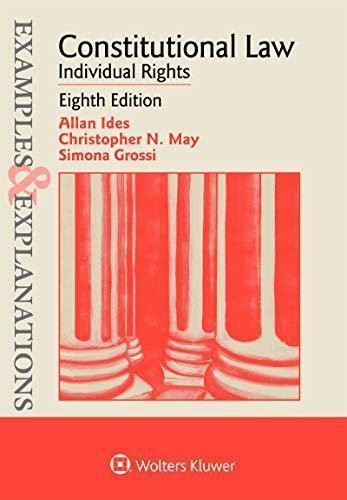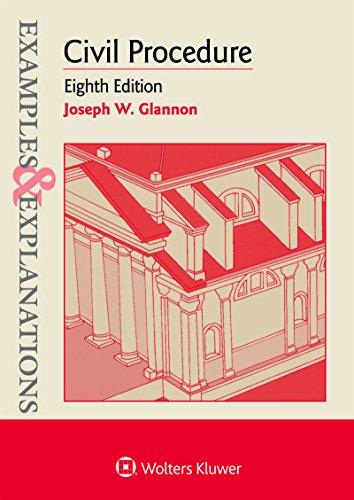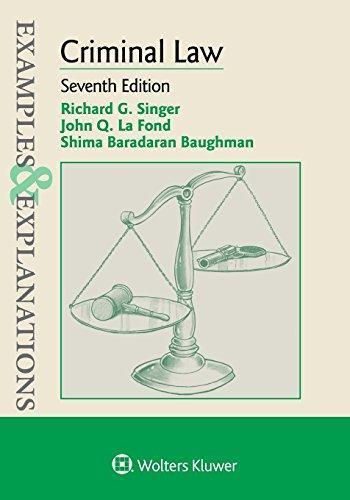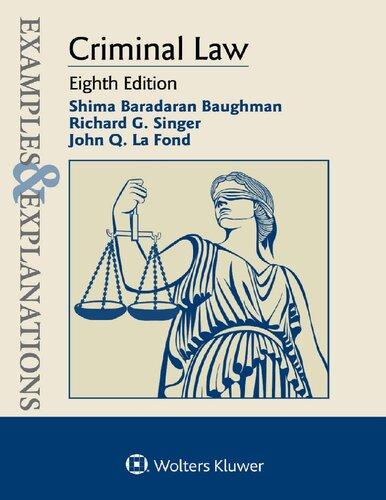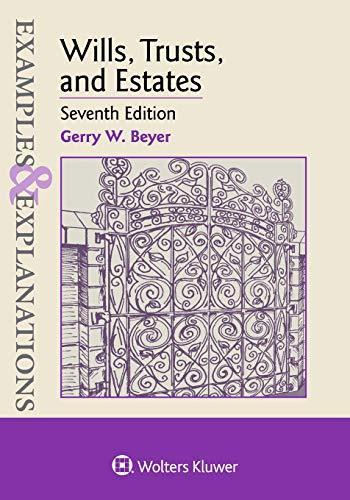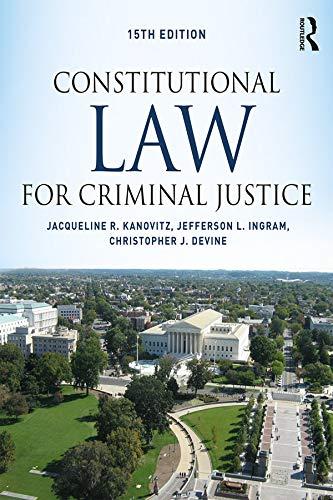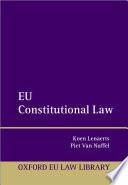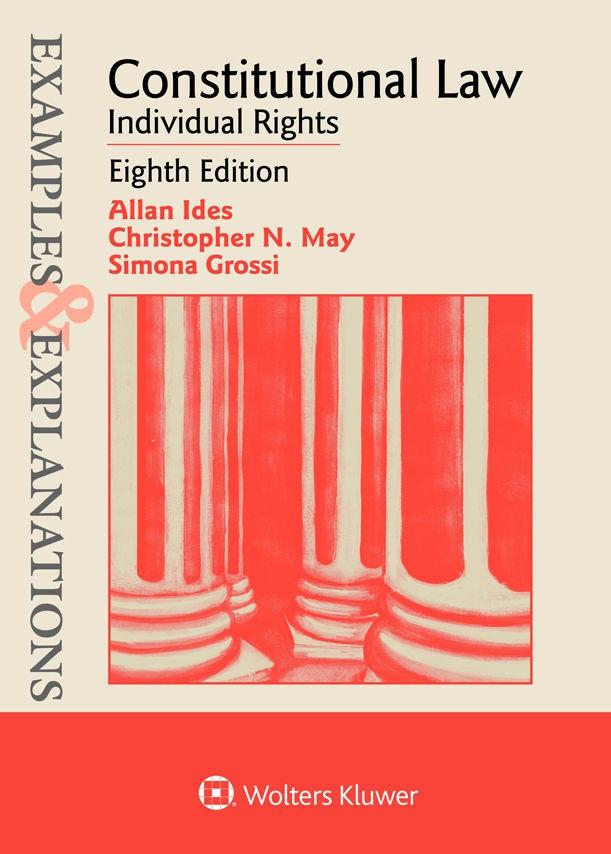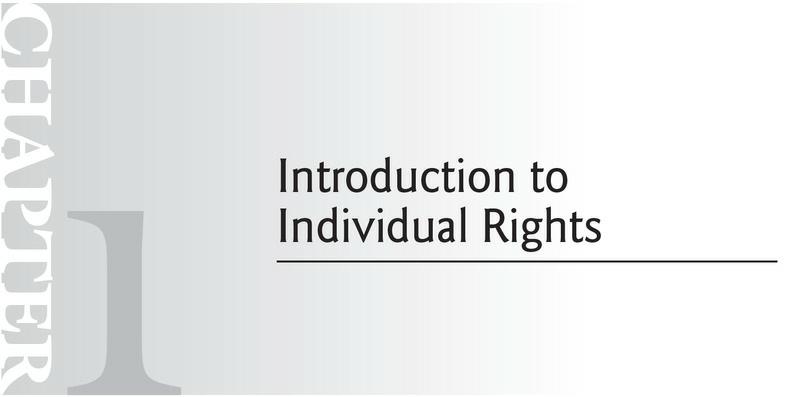Visit to download the full and correct content document: https://ebookmass.com/product/examples-explanations-for-constitutional-law-individu al-rights-8th-edition/
More products digital (pdf, epub, mobi) instant download maybe you interests ...
Examples & Explanations for Administrative Law (Examples & Explanations Series) (Ebook PDF)
https://ebookmass.com/product/examples-explanations-foradministrative-law-examples-explanations-series-ebook-pdf/
Examples & Explanations for Civil Procedure (Examples & Explanations Series) 8th Edition, (Ebook PDF)
https://ebookmass.com/product/examples-explanations-for-civilprocedure-examples-explanations-series-8th-edition-ebook-pdf/
Examples & Explanations for Criminal Law 7th Edition
https://ebookmass.com/product/examples-explanations-for-criminallaw-7th-edition/
Examples & Explanations for The Law of Torts (Examples & Explanations Series) 5th Edition, (Ebook PDF)
https://ebookmass.com/product/examples-explanations-for-the-lawof-torts-examples-explanations-series-5th-edition-ebook-pdf/
Examples & Explanations: Criminal Law 8th Edition John Q. La Fond
https://ebookmass.com/product/examples-explanations-criminallaw-8th-edition-john-q-la-fond/
Constitutional Law for a Changing America: Rights, Liberties, and Justice 10th Edition, (Ebook PDF)
https://ebookmass.com/product/constitutional-law-for-a-changingamerica-rights-liberties-and-justice-10th-edition-ebook-pdf/
Wills,
Trusts,
7th Edition
and Estates (Examples & Explanations)
https://ebookmass.com/product/wills-trusts-and-estates-examplesexplanations-7th-edition/
Constitutional Law for Criminal Justice 15th Edition, (Ebook PDF)
https://ebookmass.com/product/constitutional-law-for-criminaljustice-15th-edition-ebook-pdf/
EU Constitutional Law Koen Lenaerts
https://ebookmass.com/product/eu-constitutional-law-koenlenaerts/
Summary of Contents
Contents
Preface Acknowledgments
Chapter 1 Introduction to Individual Rights
Chapter 2 Substantive Due Process
Chapter 3 The Takings Clause
Chapter 4 The Contracts Clause
Chapter 5 Procedural Due Process and Irrebuttable Presumptions
Chapter 6 Equal Protection: Ordinary, “Suspect,” and “QuasiSuspect” Classifications
Chapter 7 Equal Protection: Fundamental Rights
Chapter 8 The First Amendment: Freedom of Speech and of the Press
Chapter 9 The First Amendment: Freedom of Religion
Chapter 10 The Right to Keep and Bear Arms
Table of Cases
Index
Contents
Preface
Acknowledgments
Chapter 1 Introduction to Individual Rights
§ 1.1 Introduction and Overview
§ 1.2 The Fourteenth Amendment: An Introductory Overview
The Text of § 1 of the Fourteenth Amendment
A Brief Historical Survey
Early Judicial Trends in Construing the Fourteenth Amendment
§ 1.3 The Incorporation Doctrine
§ 1.4 The State Action Doctrine
§ 1.4.1 The Categorical Approach
Private Performance of a Public Function
The Judicial Enforcement of Private Agreements
Joint Activity Between a State and a Private Party
State Endorsement of Private Conduct
§ 1.4.2 The Two-Part Approach
A State Actor Anomaly
§ 1.5 Congressional Enforcement of the Civil War Amendments
§ 1.5.1 Enforcement of the Thirteenth Amendment
§ 1.5.2 Enforcement of the Fourteenth Amendment
Parallel Enforcement
Nonparallel Enforcement
Congressional Interpretation
§ 1.5.3 Enforcement of the Fifteenth Amendment
Chapter 2 Substantive Due Process
§ 2.1 Introduction and Overview
The Origins of the Due Process Clause
Procedural versus Substantive Due Process
Executive Abuse of Power Standards of Review
Economic versus Noneconomic Due Process
§ 2.2 The Rise and Fall of Economic Due Process
§ 2.2.1 Economic Due Process in the Lochner Era
Liberty to Contract
The Decision in Lochner v. New York
§ 2.2.2 The Demise of Lochner
§ 2.2.3 Property and Economic Liberty Today Punitive Damages
§ 2.3 Noneconomic Liberty from Lochner to Carolene Products
§ 2.3.1 The Lochner Era and Noneconomic Liberties
§ 2.3.2 Carolene Products’ Footnote Four
§ 2.4 Griswold and the Reemergence of Unenumerated Liberties
§ 2.4.1 Penumbras and Emanations
§ 2.4.2 Alternative Approaches: Liberty and the Ninth Amendment
§ 2.4.3 The Risks in Protecting Unenumerated Rights
§ 2.4.4 The Fundamental Rights Model with Variations
The Basic Fundamental Rights Model
The Concept of Impingement
Variations on the Basic Strict Scrutiny Model
§ 2.5 The Right of Privacy and Personal Autonomy
§ 2.5.1 Marriage
§ 2.5.2 Family Integrity
Family Living Arrangements
The Parent-Child Relationship
Nonparental Visitation Statutes
§ 2.5.3 Intimate Association
§ 2.5.4 Abortion
Roe v. Wade and the Trimester
Framework
Planned Parenthood v. Casey and the End of the Trimester Approach
The Undue Burden Test
Facial versus As-Applied Challenges
§ 2.5.5 Sexual Intimacy
§ 2.5.6 Medical Treatment
A Right to Choose Certain Medical Treatment?
The Right to Reject Unwanted Medical Treatment
§ 2.5.7 The Right to Refuse Lifesaving Hydration and Nutrition
§ 2.5.8 Suicide and Physician-Assisted Suicide
§ 2.6 Other Protected Liberty Interests
§ 2.6.1 Freedom of Movement
Freedom from Physical Restraint
Freedom to Move About
§ 2.6.2 The Rights to Protection and Care
§ 2.6.3 Access to Courts
§ 2.6.4 Informational Privacy
§ 2.7 What Happened to Life?
Abortion
Subsistence Benefits
The Death Penalty
Death Caused by Government Officials
Chapter 3 The Takings Clause
§ 3.1 Introduction and Overview
§ 3.2 Condemnation and Inverse Condemnation
§ 3.3 The Requirement of Public Use
§ 3.4 An Approach to Analyzing Inverse Condemnation Problems
§ 3.5 The Difference Between Physical Occupation and Regulation
§ 3.6 Physical Occupations and Invasions
§ 3.7 Regulatory Takings
§ 3.7.1 Destroying All Use or Value
Real Property
Personal Property
Measuring Loss in Value: The Denominator Problem
§ 3.7.2 Partial Deprivations
§ 3.7.3 The Nuisance Exception
§ 3.7.4 Remedies for Temporary Regulatory Takings
§ 3.8 Conditions Attached to Building Permits
§ 3.8.1 Only Certain Types of Conditions Qualify
§ 3.8.2 The Essential Nexus Requirement
§ 3.8.3 The Rough Proportionality Requirement
The Nature of the Condition
The Extent of the Condition
Chapter 4 The Contracts Clause
§ 4.1 Introduction and Overview
§ 4.2 The Preliminary Questions
§ 4.2.1 Is There a Contractual Obligation?
Implied Contractual Obligations
State Contract Law as an Implied Contractual Obligation
§ 4.2.2 Does a Change in State Law Impair a Contractual Obligation?
§ 4.2.3 Is the Impairment Substantial?
§ 4.3 The Balancing Test and the Reserved Powers Doctrine
§ 4.4 The Special Problems of Contracts to Which a State Is a Party
Chapter 5 Procedural Due Process and Irrebuttable
Presumptions
§ 5.1 Introduction and Overview
§ 5.2 A Protected Liberty or Property Interest?
§ 5.2.1 What Constitutes Liberty?
§ 5.2.2 What Constitutes Property?
§ 5.2.3 The Relevance of Custom and Practice
§ 5.3 What Constitutes a Deprivation?
§ 5.4 The Content of Notice
§ 5.5 What Kind of Hearing Must Be Afforded?
§ 5.5.1 The “Bitter with the Sweet” Approach
§ 5.5.2 The Mathews v. Eldridge Test
§ 5.5.3 The Requirement of a Prior Hearing
§ 5.5.4 Exceptions to the Prior Hearing Requirement
§ 5.5.5 The Formality of the Prior Hearing
§ 5.6 Possible Post-Deprivation Remedies Where No Liberty or Property Interest Exists
§ 5.7 The Irrebuttable Presumption Doctrine
§ 5.7.1 Rebuttable and Irrebuttable Presumptions
§ 5.7.2 The Doctrine in Its Prime
§ 5.7.3 The Doctrine Today
Chapter 6 Equal Protection: Ordinary, “Suspect,” and “Quasi-Suspect” Classifications
§ 6.1 Introduction and Overview
§ 6.2 Equal Protection: General Principles
§ 6.2.1 Detecting Discrimination: Facial, Design, and Applied
Facial Discrimination
Discrimination by Design
Discriminatory Application
§ 6.2.2 The Prima Facie Case
Disproportionate Impact
Discriminatory Purpose
Legislative History
The Manner of Adoption
Inferring Purpose from Impact and Other
Circumstantial Evidence
Inferring Intent from Application
The Keyes Presumption
Difficulties with the Purpose Element
§ 6.2.3 Rebutting the Prima Facie Case
§ 6.3 The Rational Basis Equal Protection Test
§ 6.4 Classifications on the Basis of Race or National Origin
§ 6.4.1 Race as a Suspect Classification
The Court’s Early Treatment of Race
The Rationale for Strict Scrutiny
§ 6.4.2 Scrutiny as a Measure of Constitutionality
Compelling Interest
Narrowly Tailored
§ 6.4.3 Racial Segregation of Public Schools
Brown v. Board of Education
Implementing Brown
§ 6.4.4 Interdistrict Remedies
Proving an Interdistrict Violation
Responding to White Flight
§ 6.4.5 Remedying Segregation at the College Level
§ 6.4.6 Other Limitations on Desegregation Orders
Minimizing the Degree of Federal Interference
Duration of Federal Desegregation Orders
§ 6.4.7 Affirmative Action
Strict Scrutiny for Affirmative Action
Compelling Interests
Narrowly Tailored
§ 6.5 Classification on the Basis of Alienage
§ 6.5.1 The Standard for State and Local Laws
The Reason for Strict Scrutiny
Governmental or Political Functions
Undocumented Aliens
§ 6.5.2 The Standard for Federal Laws
§ 6.6 Classification on the Basis of Gender or Legitimacy
§ 6.6.1 Gender as a Quasi-Suspect Classification
§ 6.6.2 Mid-Level Scrutiny as a Measure of Constitutionality
Important and Legitimate Objectives
Proof of Actual Purpose
Means Substantially Related to Goal
Comparing the Tests for Gender and Race Discrimination
§ 6.6.3 Legitimacy
§ 6.7 Other Possibly Disfavored Bases of Classification
§ 6.7.1 The Rejection of New “Suspect” and “QuasiSuspect” Classes
§ 6.7.2 Discrimination Against Out-of-Staters
§ 6.7.3 Discrimination Against the Mentally Retarded
§ 6.7.4 Discrimination on the Basis of Sexual Orientation
Chapter 7 Equal Protection: Fundamental Rights
§ 7.1 Introduction and Overview
§ 7.2 Equal Protection and Fundamental Rights
§ 7.3 The Right to Vote
§ 7.3.1 The Absolute Versus the Equal Right to Vote
§ 7.3.2 Selective Denial of the Franchise
§ 7.3.3 Individual Vote Dilution: “One Person, One Vote”
The Problem: Unequal Weighting of Votes
“One Person, One Vote”
At-Large Election Schemes
Reapportionment
§ 7.3.4 Group Vote Dilution
Minimizing Group Voting Strength
Dilution Through At-Large Elections
Dilution Through Gerrymandering
Dilution Through Use of Multimember
Districts
Vote Dilution and Nonracial Groups: Partisan Political Gerrymandering
§ 7.3.5 Nondilutional Race-Based Districting
§ 7.3.6 Access to the Ballot
§ 7.3.7 Unequal Vote Count
§ 7.4 The Right to Travel
§ 7.4.1 Durational Residency Requirements
§ 7.4.2 Fixed-Point and Fixed-Date Residency Requirements
§ 7.4.3 The Equal Protection Alternative to Strict Scrutiny
§ 7.4.4 Bona Fide Residency Requirements
§ 7.5 Access to the Courts
§ 7.6 Welfare and Subsistence
§ 7.7 Access to a Basic Education
§ 7.8 A Sliding-Scale Approach to Equal Protection
§ 7.8.1 Problems with the Three-Tier Model
§ 7.8.2 Marshall’s Sliding-Scale Approach
§ 7.8.3 Plyler v. Doe
Chapter 8 The First Amendment: Freedom of Speech and of the Press
§ 8.1 Introduction and Overview
§ 8.2 Introductory Themes
§ 8.2.1 Defining Terms: Speech and Press
§ 8.2.2 Protected and Unprotected Speech
§ 8.2.3 The Distinction Between Matters of Public and Private Concern
§ 8.2.4 The Special Problem of Prior Restraints
§ 8.2.5 The Overbreadth and Vagueness Doctrines
§ 8.3 Content-Based Restrictions on Speech
§ 8.3.1 What Constitutes a Content-Based Restriction?
§ 8.3.2 Advocacy of Unlawful Conduct: The Clear and Present Danger Test
§ 8.3.3 Fighting Words, True Threats, and Hate Speech
§ 8.3.4 Free Speech Limitations on Defamation (and Other Torts)
The Burdens Imposed by the Actual Malice Standard
The Contexts in Which the Actual Malice Standard Applies
The Standards for Private-Plaintiff
Lawsuits
The First Amendment and SpeechPremised Torts Generally
§ 8.3.5 Campaign Financing, Campaign Advocacy, and Restrictions on the Initiative Process
Campaign Financing and Campaign Advocacy
Restrictions on Judicial Elections
Restrictions on the Initiative Process
§ 8.3.6 Commercial Speech
The Definition of Commercial Speech
The Rationale for Protecting Commercial Speech
The Central Hudson Test
Mandatory Disclosure Requirements
§ 8.3.7 Sexually Explicit Speech Obscenity and Pornography
A Definition of Obscenity
Nonobscene Sexually Explicit Speech
Pornography
Indecent or Vulgar Speech
Indecent Speech and the Internet
§ 8.3.8 Speech that Depicts Actual Violence or Cruelty
§ 8.3.9 Content Discrimination Within Categories of Unprotected Speech
§ 8.3.10 Compelled Speech
§ 8.3.11 Ad Hoc Balancing
§ 8.3.12 Free Speech Rights of Public Employees and Other Voluntary Participants in Government Programs
§ 8.4 Content-Neutral Restrictions on Speech: The Time,
Place, and Manner Test
§ 8.4.1 Content Neutrality
§ 8.4.2 Narrowly Tailored to Advance a Significant Governmental Interest
§ 8.4.3 Alternate Channels for Communication
§ 8.4.4 Prior Restraints
§ 8.4.5 Injunctions
§ 8.4.6 The Special Problem of Copyrights
§ 8.5 The Nature of the Public Forum
§ 8.5.1 Traditional Public Forum
§ 8.5.2 Designated Public Forum
§ 8.5.3 Nonpublic Forum
§ 8.5.4 Student Speech in Public Schools
§ 8.6 Government Speech
§ 8.7 The First Amendment Right of Association
The Right of Association and State Regulation of Elections
§ 8.8 Special Problems of the Media
§ 8.8.1 Access to Information
§ 8.8.2 Access to Criminal Proceedings
§ 8.8.3 Gag Orders in Criminal Proceedings
§ 8.8.4 The Publication of Truthful, Lawfully Obtained Information
§ 8.8.5 The Protection of Confidential Sources
§ 8.8.6 Forced Access to the Press: Print Media
§ 8.8.7 The First Amendment and Modern Technologies
The Broadcast Media
Developing Technologies Cable Operators
Developing Technologies The Internet
Chapter 9 The First Amendment: Freedom of Religion
§ 9.1 Introduction and Overview
§ 9.2 The Establishment Clause: Themes, Theories, and Tests
§ 9.2.1 Separationist Theory
§ 9.2.2 Nonpreferentialist Theory
§ 9.2.3 Three Compromise Approaches
§ 9.2.4 The Lemon Test
Secular Purpose
Primary Effect That Neither Advances Nor Inhibits Religion
Not Foster Excessive Entanglement With Religion
§ 9.3 The Establishment Clause Applied: Discrimination Between Religions
§ 9.3.1 The Ban on Officially “Established” Religions
§ 9.3.2 The Limitation on Conferring a Preferred Status
§ 9.3.3 The Limitation on Imposing a Disfavored Status
§ 9.4 The Establishment Clause Applied: The Nondiscriminatory Promotion of Religion
§ 9.4.1 Public Aid to Parochial Schools
§ 9.4.2 Prayer in Public Schools
§ 9.4.3 Other Contexts
§ 9.5 The Free Exercise Clause
§ 9.5.1 The Distinction Between Belief and Conduct
§ 9.5.2 The Protection of Religious Belief
The Right to Profess Religious Beliefs
Ecclesiastical Disputes
§ 9.5.3 The Protection of Religiously Motivated Conduct
The Purposeful Suppression or Selective Nonfunding of Religiously Motivated Conduct
The Nonpurposeful Regulation of Religously Motivated Conduct
The Incidental Burdening of Religiously Motivated Conduct
§ 9.6 The Accommodation of Religion
Chapter 10 The Right to Keep and Bear Arms
§ 10.1 Introduction and Overview
§ 10.2 District of Columbia v. Heller
§ 10.2.1 Interpreting the Second Amendment
§ 10.2.2 Applying the Second Amendment
§ 10.3 Applying Heller
Table of Cases Index
Acknowledgments
We would like to express our appreciation to our student research assistants who assisted us in the preparation of the various editions of this book: Lilly Kim (LLS ’98), Lauren Raskin (LLS ’98), Eric Enson (LLS ’99), James V. DeRossitt IV (W&L ’96), Ashley DeMoss (W&L ’97), Lawrence Striley (W&L ’95), Kristen Strain (LLS ’01), Kasha Arianne Harshaw (LLS ’02), Jessica Levinson (LLS ’05), Megan Moore (LLS ’07), Gillian Studwell (LLS ’07), Daniel Costa (UCLA ’11), Mario Grimm (LLS ’11), Mashashi Kawaguchi (LLS ’11), Vanda Long (UNC ’11), Jacquelyn Mohr (LLS ’11), Brian Casillas (LLS ’14), Lara Kuyumjian (LLS ’14), Jason Meyer (LLS ’14), Pushkal Mishra (LLS ’14), and Ashkahn Mohamadi (LLS ’14). Many thanks also to our secretaries, Ruth Busch, Liz Luk, and Diane Cochran.
§1.1 INTRODUCTION AND OVERVIEW
In one sense, the entire body of the Constitution is designed to protect individual rights. In fact, many of the Framers believed that the political structure created by the Constitution was the primary and essential vehicle through which to protect the liberty of the people. Such structural devices as the separation of powers, checks and balances, bicameralism, enumeration of powers, and federalism, among others, were thought to provide a substantial bulwark against governmental tyranny. Alexander Hamilton went further and argued that a detailed bill of rights would be affirmatively dangerous in that it “would contain various exceptions to powers which are not granted; and, on this very account, would afford a colorable pretext to claim more than were granted.” The Federalist No. 84, at 513 (Clinton Rossiter ed., 1961).
The text of the original Constitution reflects this structural bias by including only a few specific protections for what we now commonly consider individual rights. See, e.g., Art. I, § 9, cls. 2 & 3 (privilege of the writ of habeas corpus, proscription against bills of attainder and ex post facto laws); Art. III, § 2, cl. 3 (right to trial by jury in criminal cases). Yet Hamilton’s confidence in political structure was not universally shared. Some thought that the absence of a bill of rights was a major flaw in the proposed Constitution, and a number of states premised their ratification of it on a recommendation that the Constitution be amended to include such a statement of rights. See, e.g., 3 Jonathan Elliot, The Debates in the Several
State Conventions on the Adoption of the Federal Constitution as Recommended by the General Convention in Philadelphia in 1787, at 657661 (proposed amendments by Virginia). Two states, North Carolina and Rhode Island, did not ratify the Constitution until a proposed Bill of Rights had been approved by Congress and submitted to the states for ratification.
In response to these concerns and others, James Madison introduced a series of proposed amendments to the Constitution during the first session of Congress. The Bill of Rights, which was approved by Congress in 1789 and ratified by the states in 1791, was a direct product of Madison’s proposals. It includes ten amendments to the Constitution, nine of which address individual rights; the tenth reiterates the limited nature of the government created by the Constitution. In practical effect, the Bill of Rights limits the power of the federal government to transgress the rights described therein. In other words, the rights enumerated in the Bill of Rights act as a trump on the exercise of federal power.
The Supreme Court held early on that the Bill of Rights limited only the authority of the national government and not that of the states. Barron v. Mayor & City Council of Baltimore, 32 U.S. (7 Pet.) 243 (1833). Thus, although the body of the Constitution contains a few specific individual rights limitations on state authority e.g., the Privileges and Immunities Clause of Article IV, § 2, and the Contracts Clause of Article I, § 10 by and large the protection of individual rights against state encroachment was to be found, if at all, in the respective constitutions of the several states. At least, that was the case throughout much of the nineteenth century.
The adoption of the Fourteenth Amendment in 1868, however, radically changed both the Constitution’s and the national government’s role in the protection of civil rights against state interference, essentially establishing federal supremacy within this realm of civil rights. As we will see below, through a process of incorporation the Fourteenth Amendment became the constitutional vehicle through which courts now apply most provisions of the Bill of Rights to the states. In addition, the Equal Protection Clause of the Fourteenth Amendment eventually came to operate as a powerful and judicially enforceable principle of equality. Finally, the Fourteenth Amendment vested Congress with a broad authority to enforce civil rights against state encroachment. Thus, with the adoption of the Fourteenth Amendment, accompanied by subsequent judicial and congressional interpretations, the Constitution now provides substantial protection against
both federal and state encroachments on individual liberty.
In the chapters that follow, we will examine the substantive and procedural reach of a number of the more important and frequently litigated individual rights limitations on governmental authority. This chapter, however, addresses several preliminary matters. It begins with a brief historical and descriptive perspective on the Fourteenth Amendment. This is designed to provide a foundation for the multitude of doctrines that are built on and around that amendment. Although the provisions of the Bill of Rights merit their own individual consideration, the Fourteenth Amendment stands alone in its radical transformation of our system of government. Next, the chapter examines three preliminary doctrinal matters directly related to the protection of individual rights namely, the incorporation doctrine, the state action doctrine, and the scope of congressional enforcement powers under the Thirteenth, Fourteenth, and Fifteenth Amendments, otherwise known as the Civil War Amendments.
§1.2 THE FOURTEENTH AMENDMENT: AN INTRODUCTORY OVERVIEW
The Text of § 1 of the Fourteenth Amendment
Section 1 of the Fourteenth Amendment consists of two sentences. The first sentence provides: “All persons born or naturalized in the United States and subject to the jurisdiction thereof, are citizens of the United States and of the State wherein they reside.” This sentence accomplishes two things: First, it creates a definition of U.S. citizenship (“All persons born or naturalized”); second, it provides a definition of state citizenship (“reside”). Neither point is controversial today, and there is general agreement that the language of this sentence means exactly what it appears to say. The phrase “subject to the jurisdiction thereof” requires further investigation. That investigation would reveal that the phrase was designed to exclude two classes of persons children of alien enemies in hostile occupation and children of diplomatic representatives of foreign states. We could also quibble about the word “reside,” but without too great an effort, a workable and relatively noncontroversial meaning would be discovered, namely, domicile or place of permanent residence. In short, the first sentence defines citizenship at both
the federal and the state levels in relatively clear terms and with only a minimal need to look beyond the specific language used.
Despite the relative clarity of the first sentence, some reference to history is beneficial. Prior to the Civil War, the U.S. Supreme Court had held that an African American sold as a slave was not a citizen of the United States. Dred Scott v. Sandford, 60 U.S. (19 How.) 393 (1857). The Dred Scott decision, which denied the status of citizenship to slaves, former slaves, and their descendants, was viewed by Republicans as a precipitating and an infamous cause of the Civil War, and the first sentence of § 1 was designed to repeal that decision. This specific purpose would have been clear to contemporary observers, though it is a bit obscure to the modern reader. Even given that underlying purpose, however, the language of the Amendment is much broader than would have been necessary to simply overrule Dred Scott. It covers all persons born or naturalized in the United States, not just former slaves. In other words, it creates a general definition of citizenship, and we need not look beyond the actual words to discover that definition.
The second sentence of § 1 is both more complicated and less clear. It is divided into three parts. The first part provides, “No State shall make or enforce any law which shall abridge the privileges or immunities of citizens of the United States.…” The text does not define the “privileges or immunities of citizens of the United States.” One immediately thinks of the Privileges and Immunities Clause of Article IV, which protects the “Privileges and Immunities of Citizens in the several States.” See Christopher N. May, Allan Ides & Simona Grossi, Constitutional Law: National Power and Federalism, ch. 9 (8th ed. 2019) [hereinafter National Power & Federalism]. At the time the Fourteenth Amendment was adopted, judicial decisions had given some content to the “fundamental rights” protected by Article IV. See Corfield v. Coryell, 6 F. Cas. 546, 552 (C.C.E.D. Pa. 1823). Do both clauses refer to the same fundamental rights, or is there a distinction between the “privileges or immunities” held by citizens of the United States and the “privileges and immunities” held by citizens in the several states? In other words, has a new category of fundamental rights been created to coincide with the newly created definition of U.S. citizenship? And if so, what are those rights? The text, standing alone, does not provide an answer to these questions.
The next part of the second sentence provides, “[N]or shall any State deprive any person of life, liberty, or property, without due process of law.
…
” This sounds a little easier. Before a state can take away a person’s life, liberty, or property, it must provide something called due process of law. Implicitly, the rights to life, liberty, and property are not absolute. A deprivation of these rights is permissible as long as due process is satisfied. The word “process” suggests procedures; the word “due” suggests appropriate, proper, or reasonable. A person, therefore, is entitled to appropriate procedures before being deprived of life, liberty, or property. Presumably reference to accepted practices will provide guidance as to what procedures will be deemed to satisfy due process. Note also that the category “person” appears to be broader than the category “citizen.” All citizens are persons; all persons are not necessarily citizens. The Due Process Clause protects the more inclusive category.
Finally, § 1 provides, “[N]or [shall any State] deny to any person within its jurisdiction the equal protection of the laws.” The phrase “equal protection of the laws” suggests at the very least that otherwise neutral laws must be enforced in an evenhanded manner for the benefit of all who fall within the letter of their protection. But does it mean, in addition, that state laws may not discriminate or classify? In other words, does it require that the law itself be evenhanded? Assuming that this is the case and keeping in mind that all laws classify in some manner, is this potential ban on classifications limited to certain types of discriminations? If so, what types of discriminations are banned? Again, the text does not answer these questions.
This cursory examination of the text of § 1 should make at least one thing clear: A reading of a constitutional text begins, but rarely resolves, an inquiry into meaning. The language must be placed in a context that includes the surrounding historical events, as well as the specific matters that led to the enactment. Certainly this is borne out by the obscure language of the second sentence of § 1. These observations are also true even with respect to language that appears clear. The clarity may be an illusion caused by our lack of appreciation for the historical context. For example, we may think we know what equal protection of the laws means, but the authors of the text may have been writing from a very different understanding of the phrase. In short, the text cannot be read in a historical vacuum. A deeper understanding of the text requires at a minimum a passing familiarity with the historical milieu in which the Fourteenth Amendment was adopted.
A Brief Historical Survey
The context surrounding the adoption of the Fourteenth Amendment can be succinctly described as slavery, the abolition movement, the Civil War, and the Reconstruction response to events in the post-Civil War South, including the adoption of the Black Codes. The authors of the Fourteenth Amendment and those who supported it, both in Congress and in state conventions, were immersed in these events. They lived them and were responding to them.
The Thirteenth Amendment, which abolished slavery, had been ratified in 1865, but it was evident (and believed to be evident) that the institution of slavery was being replaced by a system that was designed to keep the former slaves in a condition of virtual servitude. The Black Codes, enacted by most of the southern states, severely restricted the civil rights of former slaves, including the rights to enter into contracts, to purchase property, and to sit on juries. In addition, there was evidence that former slaves were not being given full and impartial protection of otherwise neutral laws. Both formally and informally the former slaves were being treated as noncitizens.
In response to these conditions, Congress passed the Civil Rights Act of 1866, 14 Stat. 27, which provided in pertinent part:
That all persons born in the United States and not subject to any foreign power are hereby declared to be citizens of the United States; and such citizens, of every race and color, without regard to any previous condition of slavery or involuntary servitude,…shall have the same right, in every State and Territory in the United States, to make and enforce contracts, to sue, be parties, and give evidence, to inherit, purchase, lease, sell, hold and convey real and personal property, and to full and equal benefit of all laws and proceedings for the security of person and property, as is enjoyed by white citizens, and shall be subject to like punishment, pains, and penalties, and to none other.…
President Andrew Johnson had vetoed the Civil Rights bill on the ground that it was unconstitutional, and though Congress overrode the veto, a number of Republicans who supported the measure were concerned that the act exceeded the enumerated powers of Congress. This concern provided the initial impetus for the Fourteenth Amendment. One of the primary purposes of that Amendment was to ensure that Congress possessed the power to enact legislation such as the Civil Rights Act of 1866. Section 5 of the Fourteenth Amendment does precisely that. It grants Congress the power to enforce the provisions of the Fourteenth Amendment, including the so-called substantive provisions of § 1 described above. See § 1.5.
Proponents of the Fourteenth Amendment, therefore, probably understood § 1’s Privileges or Immunities Clause as encompassing the “civil rights or immunities” described in the Civil Rights Act of 1866. Those rights are
remarkably similar to the fundamental rights associated with Article IV’s Privileges and Immunities Clause, and like that clause, the Civil Rights Act prohibited discriminatory treatment of citizens exercising those rights. If this interpretation is correct, one purpose of the Fourteenth Amendment’s Privileges or Immunities Clause was to prevent states from denying U.S. citizens, as defined in the first sentence of § 1, the equal exercise of those civil rights and immunities described in the Civil Rights Act.
The legislative history of the Fourteenth Amendment supports this interpretation. That history is replete with cross-references to the Civil Rights Act, suggesting a close affinity between the act and the proposed Amendment. This interpretation also comports with the notion that Congress, through the Fourteenth Amendment, was attempting to construct a constitutional provision that would validate the prior enactment. In fact, immediately after the adoption of the Fourteenth Amendment, the Civil Rights Act of 1866 was reenacted as an enforcement of § 1 rights.
A second strand of history suggests that the Privileges or Immunities Clause may have been intended to have an even wider application. The Court, in Barron v. Mayor & City Council of Baltimore, 32 U.S. (7 Pet.) 243 (1833), had held that the Bill of Rights limits only the power of the federal government and not the power of the states. Prior to the Civil War, abolitionists rejected the soundness of Barron. For a variety of reasons, they believed that the first eight amendments to the Constitution either were, or should, be fully applicable against the states. This view was shared by a number of Republicans, many of them former abolitionists, who participated in the drafting and passage of the Fourteenth Amendment. Moreover, even those Republicans who did not expressly subscribe to the complete incorporation theory probably thought that the Privileges or Immunities Clause protected at least some additional fundamental rights beyond those listed in the Civil Rights Act of 1866. For example, the freedoms of press and speech were widely accepted as being fundamental rights held by all U.S. citizens. One cannot say definitively, however, that the purpose of the Privileges or Immunities Clause was to incorporate all or part of the first eight amendments. The surrounding history is certainly consistent with that possibility, but the available information is far from dispositive. See Raoul Berger, Government by Judiciary: The Transformation of the Fourteenth Amendment (1977) (arguing that the first eight amendments of the Bill of Rights were not incorporated against the states via the Privileges or
Immunities Clause); Michael Kent Curtis, No State Shall Abridge: The Fourteenth Amendment and the Bill of Rights (1986) (arguing precisely the opposite). Here, we are left with an ambiguous record and an indeterminate meaning.
If the Privileges or Immunities Clause was in fact designed to prevent the denial of certain fundamental rights, what purpose can be assigned to the Due Process and Equal Protection Clauses? The independent significance of the Due Process Clause is not difficult to envision. It provides procedural protection against the taking of life, liberty, or property. Again, the Republicans were convinced, with some justification, that certain individuals in particular, former slaves and Union sympathizers were being deprived of basic civil rights without proper procedures. The Due Process Clause specifically addressed that concern.
Similarly, the independent purpose of the Equal Protection Clause appears to have been to ensure that all laws would be applied to individuals in an evenhanded manner. Consider again the language of the 1866 Civil Rights Act: “[C]itizens, of every race and color,…shall have the same right… to full and equal benefit of all laws and proceedings for the security of person and property, as is enjoyed by white citizens, and shall be subject to like punishment…and to none other.…” The Equal Protection Clause speaks directly to this concern equal protection of the laws. It may be, therefore, that the Equal Protection Clause was not seen as an independent limitation on discriminatory laws. The Privileges or Immunities Clause, on the other hand, did provide protection against racial discrimination in the context of the rights protected by the clause.
Taking the foregoing together, what can be said of § 1 of the Fourteenth Amendment? First, the Privileges or Immunities Clause was seemingly intended to prevent state discrimination with respect to fundamental civil rights, such as those protected by Article IV’s Privileges and Immunities Clause. Second, the Privileges or Immunities Clause probably was thought to include certain other fundamental rights found in the Bill of Rights, such as freedom of the press and freedom of speech. Third, the Privileges or Immunities Clause may have been designed to incorporate all the provisions of the first eight amendments to the Constitution. Fourth, the Due Process Clause required states to provide fair or reasonable procedures prior to the deprivation of life, liberty, or property. Fifth, the Equal Protection Clause was likely designed to remedy a state’s unequal enforcement of the laws.
Early Judicial Trends in Construing the Fourteenth Amendment
Four years after the ratification of the Fourteenth Amendment, the Supreme Court decided the Slaughter-House Cases, 83 U.S. (16 Wall.) 36 (1872). At issue was a Louisiana statute that granted a monopoly over the butchering trade in three parishes in Louisiana. The butchers who challenged the statute claimed, among other things, that the monopoly violated the Privileges or Immunities Clause of the Fourteenth Amendment. The premise of the butchers’ argument was that § 1 of the Fourteenth Amendment had incorporated the substantive privileges and immunities previously protected by Article IV’s Privileges and Immunities Clause, among which was the right to engage in a common calling.
The majority of the Court rejected this argument, reasoning that since the Fourteenth Amendment draws a distinction between citizens of the United States and citizens of a state, the content of the Fourteenth Amendment Privileges or Immunities Clause, which specifically protects the privileges or immunities of U.S. citizens, must differ from the content of the Article IV Privileges and Immunities Clause, which protects the rights of the citizens of one state while visiting in another state. The federal privileges or immunities would not, therefore, replicate the basic liberty and property rights protected by Article IV. Instead, the federal privileges or immunities would be those that pertained to the Union as a whole, such as the right to petition the federal government. The Court’s conclusion here was contrary to the original understanding of those who wrote § 1 of the Fourteenth Amendment. The net effect of this interpretation was to severely limit the utility of the Fourteenth Amendment Privileges or Immunities Clause. For a discussion of a potential resurrection of the Privileges or Immunities Clause, see National Power & Federalism, supra, § 9.4.1; and in this volume, § 7.4.
The decision in the Slaughter-House Cases had several significant effects on subsequent judicial interpretation of the Fourteenth Amendment. First, beginning in the late nineteenth century, the Court began using the Due Process Clause as a vehicle for incorporating various provisions of the Bill of Rights against the states. In this manner, due process came to signify something more than just a protection for procedural rights. The “selective incorporation” of the Bill of Rights continued throughout the twentieth century such that most of the Bill of Rights has now been incorporated into the Fourteenth Amendment. See § 1.3. In this manner, the Due Process Clause has functioned as a partial surrogate for the moribund Privileges or
Immunities Clause.
At about the same time, the Court also began interpreting the Due Process Clause as providing protection for substantive rights not necessarily found in the Bill of Rights. The liberty of contract, for example, was deemed a fundamental right that could not be invaded by the states without sufficient justification. Allgeyer v. Louisiana, 165 U.S. 578, 589 (1897). Again, this “substantive” approach to due process operated as a substitute for the judicially eviscerated Privileges or Immunities Clause.
Finally, in the late nineteenth century, the Court began to apply the Equal Protection Clause as something more than a provision for equal enforcement of the law. In Strauder v. West Virginia, 100 U.S. (10 Otto) 303 (1880), for example, the Supreme Court struck down a statute that prohibited African Americans from serving on juries. This interpretation of the Equal Protection Clause filled another gap created by the questionable decision in the Slaughter-House Cases by putting teeth into the concept of equality in the context of basic civil rights. In addition, the Court interpreted the Equal Protection Clause as applicable to all races, Yick Wo v. Hopkins, 118 U.S. 356 (1886), despite what one could characterize as the narrower focus of the specific concerns that led to the adoption of the Amendment. The scope of this antidiscrimination thrust was, however, limited by the separate-but-equal doctrine announced in Plessy v. Ferguson, 163 U.S. 537 (1896). See § 6.4.1.
In short, by the end of the nineteenth century, the foundation for the modern law of the Fourteenth Amendment was established. That foundation consists of a combination of the amendment’s text, the pre- and postratification history, the legislative intent, and a developing jurisprudence of interpretation and application. The foundation includes a commitment to the judicial protection of both substantive and procedural rights, as well as to an emerging concept of equality under the law.
§1.3 THE INCORPORATION DOCTRINE
As was noted above, the Bill of Rights by its own force applies only to action by the federal government. However, most of the provisions of the Bill of Rights are now fully enforceable against state or local government action by virtue of the incorporation doctrine, a doctrine through which specific provisions of the Bill of Rights have been absorbed into the Due Process
Clause of the Fourteenth Amendment. Thus, if public school students claim a violation of their rights of free speech, the First Amendment, as incorporated by the Due Process Clause of the Fourteenth Amendment, will provide the students with a constitutional basis for their claims. This is so because the First Amendment in effect now operates as a limitation on state and local power by virtue of the Fourteenth Amendment.
The process of absorption began in the late nineteenth century, when the Court held that the taking of private property for public use without just compensation violates “the due process of law required by the Fourteenth Amendment.” Chicago, Burlington & Quincy Railroad Co. v. Chicago, 166 U.S. 226, 241 (1897). The Chicago, Burlington Court did not, however, describe the Takings Clause as having been “incorporated” by the Fourteenth Amendment; rather, it concluded that the principle of just compensation was “fundamental” to our system of civil liberties and that the Due Process Clause of the Fourteenth Amendment embraced all such fundamental principles. The question in any case, therefore, was not whether in some technical sense a provision of the Bill of Rights had literally become part of the Fourteenth Amendment, but whether the claimed right was fundamental to our system of justice. Under this approach, not all provisions of the Bill of Rights have qualified for inclusion as part of due process. See, e.g., Hurtado v. California, 110 U.S. 516 (1884) (Fifth Amendment requirement of a grand jury indictment not included in Fourteenth Amendment right of due process).
The fundamental rights approach to due process was reaffirmed in Twining v. New Jersey, 211 U.S. 78, 98 (1908), where the Court declined to consider whether the Bill of Rights, in its entirety, had been incorporated by the Fourteenth Amendment. The Court deemed the “weighty arguments” in favor of total incorporation to have been foreclosed by prior decisions applying the fundamental rights model. According to the Twining Court, a right is protected by the Due Process Clause “not because [it is] enumerated in the first eight Amendments, but because [it is] of such a nature that [it is] included in the conception of due process of law.” Id. at 99.
One of the most articulate and often-quoted descriptions of the fundamental rights approach to due process incorporation is found in Justice Benjamin Cardozo’s opinion for the Court in Palko v. Connecticut, 302 U.S. 319 (1937). By the time of that decision, the Court had already recognized that several provisions of the Bill of Rights were enforceable against the states via the Fourteenth Amendment, including the freedoms of speech and
